SEGA Company

Sega Corporation is an international company that produces video games and (until 2001) equipment for them. Sega's head office is located in the Shinagawa Special District of Tokyo. Sega of America is located in Irvine, California, where they distribute games and arcades in North America. The Sega Europe office is located in Brentford (a suburb of London), Sega Publishing Korea is in Seoul.
Sega was founded on June 3, 1960 by American businessmen Martin Bromley and Richard Stewart under the name Nihon Goraku Bussan. Shortly thereafter, the company acquired the assets of its predecessor, Service Games of Japan. Five years after acquiring arcade game importer Rosen Enterprises, it became Sega Enterprises, Ltd. In 1966, Sega developed its first arcade game, Periscope. Sega was sold to Gulf and Western Industries in 1969. Following a decline in the arcade business in the early 1980s, Sega began developing video game consoles, starting with the SG-1000 and the Master System, but had to compete with competitors such as the Nintendo Entertainment System. In 1984, Sega executives David Rosen and Hayao Nakayama led a management buyout of the company with financial support from CSK Corporation.
In 1988, Sega released its next gaming system, the Sega Mega Drive. The Mega Drive struggled to compete in Japan, but achieved success overseas with the release of Sonic the Hedgehog in 1991 and briefly surpassed its main rival in the US, the Super Nintendo Entertainment System. Later that decade, Sega suffered several commercial failures such as the 32X, Saturn, and Dreamcast. In 2001, Sega ceased producing game systems to become a third-party developer and publisher, and was acquired by Sammy Corporation in 2004. In the years since the acquisition, Sega has become more profitable. Sega Holdings Co. Ltd. was created in 2015, Sega Corporation was then renamed Sega Games Co., Ltd., and its arcade, entertainment and toy divisions were spun off into other companies. In 2020, Sega Games and Sega Interactive were merged and renamed again as Sega Corporation.
Story
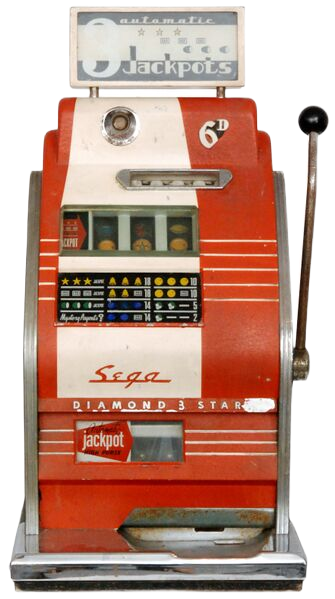
In 1940, American businessmen Martin Bromley, Irving Bromberg and James Humpert founded Standard Games in Honolulu, Hawaii. Their goal was to provide amusement machines, including slot machines, to military bases, since the increase in military personnel with the outbreak of World War II would create a demand for entertainment. After the war, the founders sold Standard Games in 1945 and founded a new company, Service Games, in 1946, so named because of its military focus. After the US government outlawed slot machines in its territories in 1952, Bromley sent his employees, Richard Stewart and Ray LeMaire, to Tokyo to found Service Games of Japan to supply American bases in Japan with amusement slot machines.
A year later, the five formed Service Games Panama to control Service Games' operations around the world. Over the next seven years, the company expanded to distribute its products in South Korea, the Philippines and South Vietnam. The name Sega, an acronym for Service Games, was first used in 1954 on the Diamond Star slot machine.
Due to the notoriety resulting from the US government's investigation into criminal business practices in the industry, Service Games of Japan was dissolved on May 31, 1960. On June 3, Bromley established two companies that would take over the business activities of the dissolved company, Nihon Goraku Bussan and Nihon Kikai Seizō. These two new companies acquired all of the assets of Service Games of Japan. Kikai Seizō, operating under the name Sega, Inc., focused on producing slot machines. Goraku Bussan, operating under the name Utamatic, Inc., was engaged in the distribution and operation of automatic machines, particularly jukeboxes. The companies merged in 1964, retaining the name Nihon Goraku Bussan.
During the same time period, David Rosen, an American US Air Force officer stationed in Japan, opened a photo booth business in Tokyo in 1954. This company became Rosen Enterprises, and in 1957 began importing electromechanical arcade machines into Japan. In 1965, Nihon Goraku Bussan acquired Rosen Enterprises to form Sega Enterprises, Ltd. Rosen was named CEO and managing director, Stewart was named president, and LeMaire was named director of planning. Shortly thereafter, Sega stopped leasing machines to military bases and shifted its focus from slot machines to coin-operated entertainment machines. The company imported Rock-Ola jukeboxes, pinball games from Williams, and light gun games from Midway Manufacturing.
The word "Sega" in red
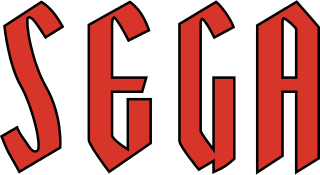
Because Sega imported used machines that required frequent maintenance, it began constructing replacement guns and paddles for its imported games. According to former Sega director Akira Nagai, this led the company to develop its own games. The first electro-mechanical arcade game released by Sega was the submarine simulator Periscope, released worldwide in the late 1960s. The game featured lighting and sound effects that were considered innovative, and was a success in Japan. It was then exported to malls and department stores in Europe and the United States and helped standardize the 25 cents per game price for arcade games in the United States. Sega was surprised by the success, and for the next two years the company produced and exported eight to ten games a year. Periscope's worldwide success led to a "technological renaissance" in the slot machine industry, which was revitalized by the wave of "audiovisual" electromechanical games that followed Periscope in the late 1960s and early 1970s. However, rampant piracy forced Sega to stop exporting its games around 1970.
In 1969, Sega was sold to American conglomerate Gulf and Western Industries, although Rosen remained as CEO. In 1974, Gulf and Western created Sega Enterprises, Ltd., a subsidiary of the American company, renamed Sega Enterprises, Inc. Sega released Pong-Tron, its first video game, in 1973. Despite late competition from Taito's hit arcade game Space Invaders in 1978, Sega prospered thanks to the arcade video game boom of the late 1970s, and by 1979 its revenues had grown to over US$100 million. During this period, Sega acquired Gremlin Industries, which produced microprocessor arcade games, and Esco Boueki, a coin-operated game distributor founded and owned by Hayao Nakayama. Nakayama was promoted to head of Sega's Japanese operations. In the early 1980s, Sega was one of the five largest arcade game manufacturers operating in the United States as the company's revenues grew to $214 million. Head On was released in 1979, introducing dot-eating gameplay that Namco later used in Pac-Man. In 1981, Sega licensed Frogger from Konami, its most successful game to date. In 1982, Sega introduced the first game with isometric graphics, Zaxxon.
Entering the gaming systems market
Sega's first video game console
Following a downturn in the arcade business beginning in 1982, Gulf and Western Corporation sold its U.S. assets and the licensing rights to its arcade games to Bally Manufacturing in September 1983. Gulf and Western retained Sega's North American research and development division and its Japanese subsidiary Sega Enterprises, Ltd. As the company's arcade business declined, the president of Sega Enterprises, Ltd. Nakayama insisted that the company use its hardware experience gained from years in the arcade industry to develop new gaming systems. This was supposed to allow the company to enter the Japanese home video game console market, which at that time was in its infancy. The first model developed was the SC-3000, a computer with a built-in keyboard, but when Sega learned of Nintendo's plans to release the Famicom game console, it began development of the SG-1000 console in parallel with the SC-3000. Rebranded versions of the SG-1000 were released worldwide. The SG-1000 sold 160,000 units in 1983, far exceeding Sega's projections of 50,000 in its first year, but was significantly outpaced by the Famicom. This was partly because Nintendo was expanding its game library by bringing in third-party developers, while Sega was hesitant to partner with companies it competed with in developing arcade games.
Sega SG-1000
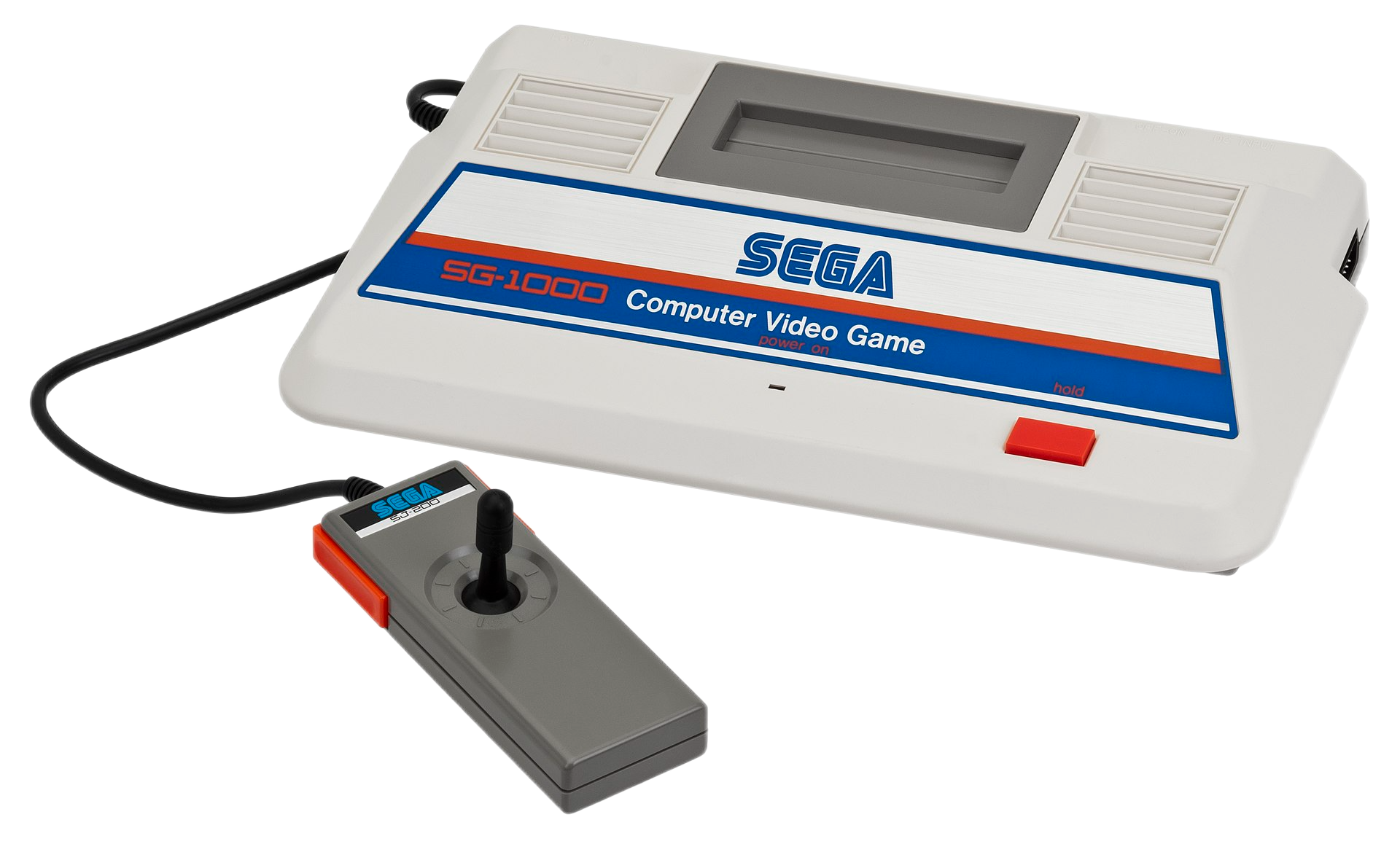
The SG-1000 is a home gaming system developed and manufactured by the Japanese company Sega. It was first introduced in 1983 and its release date coincided with the release of Nintendo's Family Computer in Japan. Sega developed several versions of the SG-1000, including the SC-3000 home computer and the updated SG-1000 II in 1984. The Sega Mark III followed in 1985 with improved features, including a new video processor. The Sega Mark III formed the basis of the Master System, which was released in 1986 and sold worldwide.
The development of the SG-1000 was motivated by the decline in popularity of games due to the downturn in the arcade game industry that began in 1982. The initiator of the creation of the gaming system was the president of Sega Enterprises, Hayao Nakayama. After the release of the SG-1000, Sega Enterprises took over the ownership of CSK Corporation, and this was followed by the release of the second version of the game system, SG-1000 II. The SG-1000's game library, including the SC-3000, consisted of 76 games on game cartridges and 29 games on Sega My Cards, all of which were compatible with the Mark III and the Japanese version of the Master System.
In November 1983, Rosen announced his intention to retire as president of Sega Enterprises, Inc. on January 1, 1984. Jeffrey Rochlis was announced as Sega's new president and chief operating officer. Soon after the start of sales of the SG-1000, Gulf and Western Corporation began to get rid of its non-core businesses due to the death of its founder, Charles Blundorn. Nakayama and Rosen organized a management buyout of the Japanese subsidiary in 1984 with financial support from CSK Corporation, a well-known Japanese software company. Sega's Japanese assets were purchased for $38 million by a group of investors led by Rosen and Nakayama. Isao Okawa, head of CSK, became chairman of the board of directors, and Nakayama was appointed CEO of Sega Enterprises, Ltd.
Sega Master System
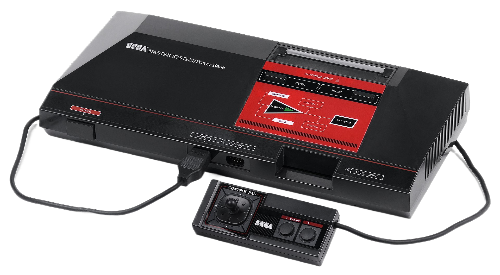
The Sega Master System is a third generation 8-bit video game console developed and published by Sega. The console was originally released in Japan in 1985 under the name Sega Mark III. After being redesigned for North American release, the console was renamed Master System and released in 1986 in the United States, 1987 in Europe, and 1989 in Brazil. The Master System was re-released in Japan in 1987, differing from export models by having additional features. The Mark III, like the original Master System models, could accept both regular cartridges-officially called Mega Cartridges-and bank card-sized Sega Cards, which sold for less than cartridges. Master System II and later models did not have a card slot.
The Master System, the successor to the SG-1000, was created as a direct competitor to the Nintendo Entertainment System. Unlike its rival, the Master System used more modern hardware, but despite this, it failed to beat Nintendo in sales in Japan and North America. At the same time, the console achieved significantly greater sales success in Europe and Brazil. Compared to the NES, the Master System's game library had far fewer games due to Nintendo's licensing policies, which required publishers to make NES games exclusive.
Total sales of the console, excluding Brazil, are estimated at 13 million units. The system was well received and influenced the development of the Sega Mega Drive. The Master System has released some well-known games, but overall reviewers are critical of its small library of games. As of 2015, the Master System is the longest-running video game console - over 30 years - due to its popularity in Brazil, where its production continues.
Sega Mega Drive

In the late 1980s, as the arcade game market began to grow again, Sega was one of the most recognizable gaming brands. In slot machines, the company has focused on producing games for a wide range of tastes, including racing games and side-scrollers. On October 29, 1988, Sega released the Mega Drive, the successor to the Master System, in Japan. The release was overshadowed by the release of Super Mario Bros. 3 from Nintendo a week earlier. Positive reviews in Famitsu and Beep magazines! helped gain user interest, but in the first year Sega shipped only 400,000 units.
The Mega Drive struggled to compete with the Famicom and was behind Nintendo's Super Famicom and NEC's PC Engine in Japanese sales throughout the 16-bit era. For the North American launch, where the console was renamed Genesis, Sega did not have a sales and marketing organization. After Atari turned down an offer to market the console in the region, Sega launched it through its own subsidiary, Sega of America. Genesis was introduced in New York and Los Angeles on August 14, 1989, and in the rest of North America later that year. The European version of the Mega Drive was released in September 1990.
Former Atari executive and new Sega of America president Michael Katz developed a two-pronged strategy to increase sales in North America. First, he implemented a marketing campaign that pitted the Sega Genesis against the Nintendo gaming system, emphasizing the more arcade-like gaming experience available on the Genesis with slogans such as "Genesis does what Nintendon't." Second, Katz began building a game library that included games using the names and likenesses of famous celebrities such as Michael Jackson's Moonwalker and Joe Montana Football. However, Sega found it difficult to overcome Nintendo's ubiquitous presence in homes. On behalf of Nakayama, Katz's goal was to sell a million systems in the first year of operation, but actual sales were only half that figure.
After the launch of the Mega Drive, Sega began looking to create its own flagship range of games to compete with Nintendo's Mario. As a result, a new character was born - Sonic the Hedgehog - who later became the main character of one of the highest-grossing video game franchises in history. The concept originated from a technology demo created by Yuji Naka, in which a character moved at high speed inside an ornate pipe, taking the shape of a ball. This idea was brought to completion by game designer Naoto Oshima, who created the character's image, and Hirokazu Yasuhara, who worked on the game level design. Sonic's color was chosen to match the cobalt blue Sega logo, and his shoes were inspired by Michael Jackson's boots.
The official mascot of Sega

In mid-1990, Tom Kalinske took over as head of Sega of America, replacing the departed Michael Katz. Although Kalinske was new to the world of video games, he brought in a group of experienced consultants. A proponent of the razor-and-blades business model, Kalinske developed a four-point strategy: lowering the price of the Mega Drive, developing games for the American market with American developers, increasing aggressive advertising campaigns, and replacing Altered Beast, which came standard with the Mega. Drive, on Sonic the Hedgehog. Although the plan was disapproved by the Japanese board of directors, Nakayama approved it, telling Kalinska, “I hired you to make decisions about Europe and the Americas, so go ahead.”
Thanks in large part to the popularity of Sonic the Hedgehog, the Mega Drive outsold its main competitor, the Super Nintendo Entertainment System (SNES), in the United States during the 1991 Christmas season, nearly doubling its sales figures. By January 1992, Sega held 65% of the 16-bit gaming system market. For four consecutive Christmas seasons, Sega outsold Nintendo thanks to the Mega Drive's earlier launch, lower price, and larger library of games than the SNES at its launch. Nintendo's share of the 16-bit market in the United States fell from 60% in 1992 to 37% by the end of 1993. In 1994, Sega claimed 55% of all 16-bit platform sales, while the SNES outsold the Mega Drive between 1995 and 1997.
Sega Game Gear

In 1990, Sega introduced the Game Gear, a portable gaming system designed to compete with Nintendo's Game Boy.
The Sega Game Gear is a fourth-generation 8-bit handheld gaming system released by Sega. The system went on sale on October 6, 1990 in Japan, in April 1991 in North America and Europe, and in 1992 in Australia. The Game Gear was designed as a direct competitor to Nintendo's Game Boy, featuring a backlit color screen and the ability to play in low-light conditions. Despite this, the system had several drawbacks, including high power consumption and a relatively small library of games, which prevented it from overtaking its main competitor in sales.
When developing the Game Gear, it was decided to use hardware based on the Master System. Inside the Game Gear is an 8-bit Zilog Z80 processor clocked at 3.5 MHz, along with 8 KB of RAM and an additional 16 KB of video memory. The Game Gear is powered by six AA batteries, providing 3 to 5 hours of operation. The system has a 3.2-inch (81 mm) display capable of displaying up to 32 colors out of a palette of 4096 colors. The similarity to the Master System architecture allowed for easy porting of Master System games to the Game Gear.
Over the course of its existence, the Game Gear received a number of modifications and accessories, including a TV tuner and a game adapter from the Master System. Over 300 games were released for the platform, including ports from the Master System. Although the Game Gear sold over 11 million units, it eventually received mixed reviews and failed to surpass the Game Boy in terms of sales and popularity. Sega ceased production of the Game Gear in 1997, but Majesco Entertainment licensed a budget version of the system in 2000. In 2020, for Sega's 60th anniversary, a special edition of the Game Gear Micro and a new game for the system, GG Aleste 3, were released.
Sega Mega-CD

On December 1, 1991, Sega released an add-on for the Mega Drive game system in Japan called Mega-CD, which used CD-ROM technology and cost 49,800 yen. This device had a number of additional features, including a second, faster processor, significantly expanded system memory, a graphics chip that performed Sega arcade-like scaling and sprite rotation, and an additional sound chip. The device was released in North America on October 15, 1992 as the Sega CD, priced at US$299, and was released in Europe in 1993 as the Mega-CD. However, the Mega-CD sold only 100,000 units in Japan during its first year of sales, which was significantly below expectations.
Sega Mega-CD is an addition to the Sega Mega Drive game console from Sega, released as part of the fourth generation of gaming systems. In North America the system was called Sega CD. It was released in Japan on December 12, 1991, in North America on October 15, 1992, and in Europe on April 2, 1993. The device improved the capabilities of the Mega Drive and added the ability to play games recorded on a CD, listen to audio CDs, and play CD+G discs.
The main benefit of using CD technology was the increase in storage capacity, allowing games to grow nearly 320 times larger than Mega Drive cartridges. This advantage led to full motion video games being released for the console, such as Night Trap, which sparked controversy and became the subject of congressional hearings on violence in video games. Sega developed the console in partnership with JVC and refused to consult with its American division until the project was completed. The American division had to assemble its own copies from various components in order to obtain a working prototype. The console was redesigned and re-released several times by Sega and licensed third-party developers.
The Sega CD game library included well-known and well-received games such as Sonic CD, Lunar: The Silver Star, Lunar: Eternal Blue, Popful Mail and Snatcher, as well as many Genesis ports and critically acclaimed FMV games. By March 1996, the Sega CD had sold 2.24 million units, after which Sega discontinued the system to focus on development of the Sega Saturn. Retrospective reviews of the system have been mixed, with reviewers praising some of the games and functionality, but also criticizing it for its lack of deep games, high price, and lack of support from Sega.
Sega Pico
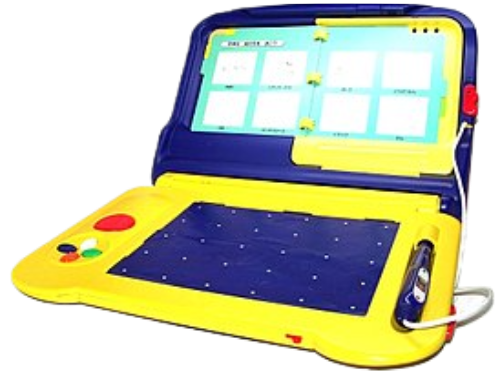
Sega Pico, also Kids Computer Pico, is an educational gaming console from Sega Toys, a division of Sega Corporation. The Pico console was positioned as an “edutainment” device and was aimed at children aged 3 to 7 years. Pico was released in June 1993 in Japan and November 1994 in North America and Europe, and was later released in China. It was replaced by the improved Advanced Pico Beena model, which was released in Japan in 2005.
In Japan, Pico was sold prior to the release of Beena, but in North America and Europe, Pico was less successful and was discontinued in early 1998, although it was re-released by Majesco Entertainment. Pico games were aimed at gaming education for children and featured licensed animated characters such as those from Sega's Sonic the Hedgehog series. Sega reported sales of 3.4 million Pico consoles and 11.2 million game cartridges sold, as well as more than 350,000 Beena consoles and 800,000 cartridges sold.
Sega 32X

Sega 32X is an add-on for the Sega Mega Drive game console. The 32X, codenamed Project Mars, was designed to expand the capabilities of the Mega Drive and served as a transition console to the 32-bit era until the release of the Sega Saturn. Independent of the Mega Drive, the 32X uses its own game cartridges and has its own library of games. It was distributed under the names Super 32X in Japan, Genesis 32X in North America, Mega 32X in Brazil, and Mega Drive 32X in all other regions.
Introduced by Sega at the Consumer Electronics Show in June 1994, the 32X was marketed as a low-cost option for consumers wanting to play 32-bit games. It was developed in response to the Atari Jaguar and fears that the Saturn would not hit the market by the end of 1994. Initially, the 32X was conceived as a new, independent console, but at the suggestion of Sega of America head Joe Miller and his team, it became an addition to the Mega Drive and became more powerful. The final design contained two Hitachi SuperH-2 32-bit CPUs and a 3D graphics processor.
Since Sega announced that the 32X would be released in Japan at the same time as the Saturn, the expansion failed to attract third-party video game developers and consumers. The rushed release of the 32X reduced the time available for game development, resulting in a weak library of 40 games that did not fully utilize the device's hardware. Sega produced 800 thousand copies of the 32X and sold approximately 665 thousand units by the end of 1994. Other copies sold at deep discounts until Sega discontinued the 32X in 1996, turning its attention to the Saturn. A version of Neptune was planned that combined both the Mega Drive and the 32X, but was canceled due to doubts about the viability of the product.
The 32X's library included ports of arcade games such as After Burner, Space Harrier and Virtua Fighter. id Software also ported Doom from the PC to the 32X, but was forced to cut a third of the game's levels due to time constraints. The 32X is considered a commercial failure. Initial reception was positive, with reviewers highlighting the low price and increased features compared to the Mega Drive. However, later reviews were mostly negative due to the game's small library, poor timing of the release, and fragmentation of the Mega Drive market.
Sega Saturn
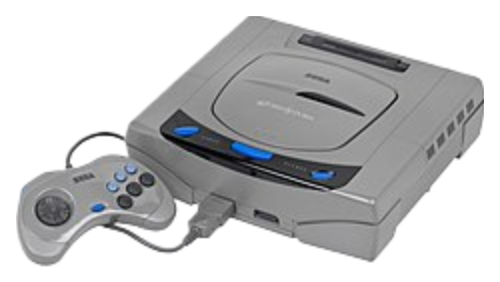
The Sega Saturn is a home video game console developed by Sega and released on November 22, 1994 in Japan, May 11, 1995 in North America, and July 8, 1995 in Europe. Part of the fifth generation of video game consoles, it became the successor to the successful Sega Genesis game console. The Saturn has a dual-processor architecture. The games were released in CD-ROM format, and the game library consists of both original games and ports of arcade games.
For the console, you could buy add-on cartridges, for example, a cartridge to increase RAM memory by 4 megabytes, a cartridge to store game saves, or a cartridge to improve 2D animation.
Development of the Saturn began in 1992, and that same year saw the debut of the Sega Model 1, a new arcade system with 3D graphics support. The Saturn hardware was designed around the new SuperH-2 processor from the Japanese company Hitachi. In early 1994, Sega added another graphics processor to better compete with Sony's upcoming PlayStation.
Sega Nomad
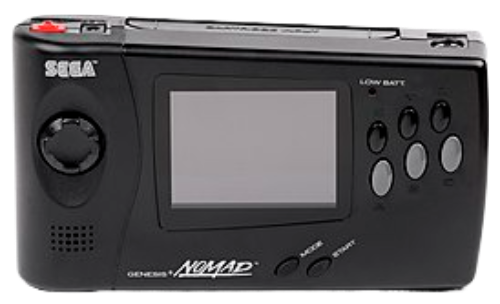
The Genesis Nomad, also known as the Sega Nomad, is a portable version of the Sega Mega Drive home video game console, released in 1995 by Sega for the North American market. The console was based on another portable console, the Mega Jet, which is a version of the Mega Drive designed for use on Japan Airlines aircraft. The Nomad was the last portable system released by Sega. It can also be connected to a TV using the video output.
Released at the end of the Mega Drive era, the Nomad video game console had a short lifespan. It was sold exclusively in North America and used region blocking. Due to Sega's focus on the Sega Saturn, the Nomad received little support and was incompatible with several Mega Drive peripherals, including the Power Base Converter, Sega CD, and 32X. Nomad sold approximately 1 million copies and is considered a commercial failure.
Nomad does not have its own game library and instead uses games released for the Mega Drive. At the time of Nomad's release, there were over 500 games that could be played on the console. At the same time, Sega decided not to add the game to the console bundle. Nomad can run unlicensed, homebrew and pirated games made for the Mega Drive. Some older third-party games have problems running on the Nomad, but can be run successfully using the Game Genie device. Due to incompatibility with Mega Drive add-ons, the console cannot run games for the Sega Master System, Sega CD and Sega 32X. The set-top box uses two regional blocking methods, physical and software, but ways have been found to bypass them.
Sega Dreamcast
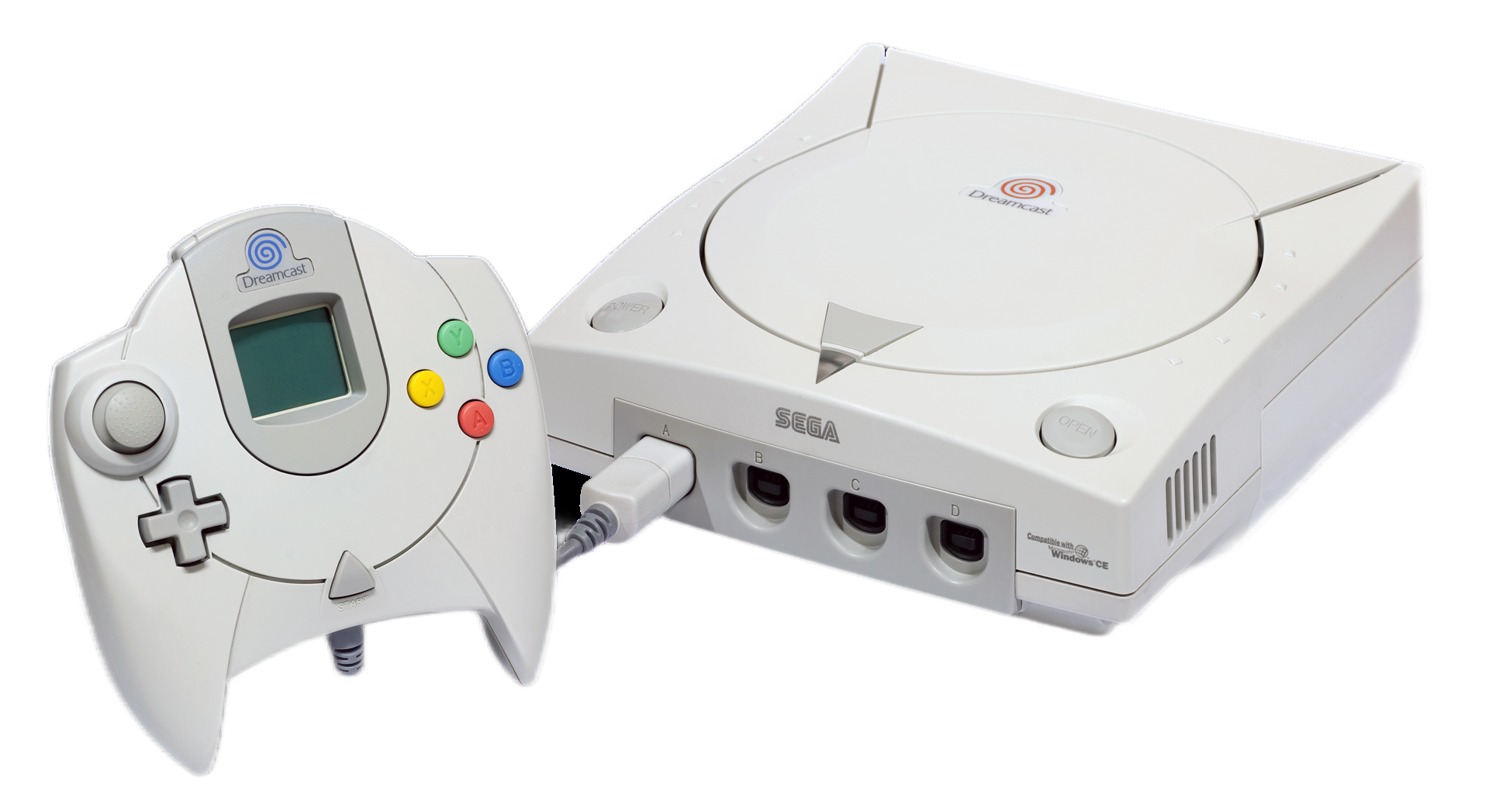
The Dreamcast is a home video game console released by Sega on November 27, 1998 in Japan, September 9, 1999 in North America, and October 14, 1999 in Europe. It was the first of the sixth generation of gaming systems, and preceded Sony's PlayStation 2, Nintendo's GameCube and Microsoft's Xbox. The Dreamcast was Sega's last home gaming system, ending the company's eighteen-year history in the console market.
Unlike the Sega Saturn, the Dreamcast was designed to keep costs down with "off-the-shelf" components such as the Hitachi SH-4 CPU and NEC PowerVR2 GPU. Released in Japan to a lukewarm reception there, the Dreamcast successfully entered the US market thanks to a massive marketing campaign, but interest in the system steadily waned as Sony built hype for the upcoming PlayStation 2. Despite several consecutive price cuts, sales fell short of expectations Sega, and the company continued to suffer significant financial losses. Following a change in management, Sega discontinued the Dreamcast on March 31, 2001, exiting the video game console business and repurposing itself as a game publisher. The Dreamcast has sold 9.13 million units worldwide.
Although the Dreamcast was initially successful, it was unable to hold its own against the PlayStation 2 and was discontinued before the Xbox and Nintendo GameCube entered the console market.
In 2000, Sega Enterprises was renamed Sega Corporation, the following year the Dreamcast was discontinued, and Sega ceased producing home gaming platforms.
Since 2001
In 2001, there was a dramatic change of direction: Sega stopped producing home consoles, but its Sega NAOMI arcade machine was still in production. The company switched to producing games for all platforms of other companies, including Nintendo GameCube, PlayStation 2, Game Boy Advance, Nintendo DS, PlayStation Portable and Xbox.
In 2003, very difficult times came. After the death of Isao Okawa, who spent more than $40 million on the development of Sega, CSK put Sega Corporation up for auction. Sammy was the first bidder, but the deal never materialized. Other contenders included Namco, Electronic Arts and Microsoft. In August 2003, Sammy bought a 22% stake, and Sammy chairman Hajime Satomi became Sega's chief executive. Under his leadership, Sega turned a profit for the first time.
In mid-2004, Sammy acquired a controlling stake worth $1.1 billion, and a new company, Sega Sammy Holdings, was created - one of the largest manufacturers of computer games. In the same year, SIMS became independent from Sega.
On March 9, 2005, Sega bought the British company Creative Assembly (known for the Total War series of games), but sold Visual Concepts to the American publisher Take-Two Interactive.
In 2006, Sega bought Sports Interactive, which produces the famous series of games called Football Manager.
Since 2003, the company has been collaborating with Western developers such as Obsidian Entertainment, Gearbox Software and BioWare, but has been closing its studios: Sega Studio USA merged with Sonic Team after the release of Nights: Journey of Dreams, Sega Studios San Francisco was closed after the release of games Iron Man 2, and Sega Racing Studio, which was bought by Codemasters.
In 2010, Sega began re-releasing games from the Dreamcast; over the next three years, 6 games were ported to the seventh generation consoles. In the same year, Sonic Team developed the first episode of the game Sonic the Hedgehog 4.
In 2011, Sega purchased Three Rings Design and created a new internal Yakuza studio, which included employees from the New Entertainment R&D Dept, which created the Super Monkey Ball and Yakuza series.
In 2013, Sega bought developer Relic Entertainment for $26.6 million. In the same year, the publisher acquired Index Corporation, which owns Atlus.
At the end of June 2023, Microsoft expressed a desire to buy Sega and a number of other companies, and although Sega itself stated that it had a good relationship with Microsoft, the company refused this offer.
At the end of July 2023, Sega announced its imminent purchase of Rovio Entertainment, Sega stated that it had already received all the necessary approvals and expects that the purchase will be completed on August 7, the purchase price is $776 million (€706 million).
On August 10, 2023, news emerged that Sega was close to completing its purchase of Rovio Entertainment. Rovio said: "With the 90% threshold having been met and the necessary regulatory approvals obtained, Rovio will become part of the Sega family upon completion of the offering, expected on August 17."
On August 18, 2023, Sega completed its purchase of Rovio Entertainment, now officially part of the Sega company.
On November 2, 2023, information appeared about the “super game”, which is being developed by Sega, the company stated that the development of this super game is moving forward, and it is also planned that the “Super Game” will be released in 2026.
Internal structure
In 1980, the corporation was divided into ten teams with serial numbers. In 2000, Sega decided to transform its teams into separate developers, with a corresponding name change. However, AM8 changed its name to Sonic Team when the first game in the Sonic the Hedgehog series was released.
Since 2003, the consolidation of internal studios has been taking place. That same year, United Game Artists merged with Sonic Team, and in 2004, WOW Entertainment and Overworks merged and became Sega WOW. After the merger, Hitmaker and Sega Rosso became known as Sega AM3.
In addition, since 2004, the company has been divided into 2 research departments (English Research & Development, R&D): consumer and entertainment department. The first department is mainly engaged in the development of games for consoles, computers and mobile devices. The head of the consumer department is Toshihiro Nagoshi.
The entertainment department primarily works on creating arcade games. The head of the department is Hiroshi Yagi.
Products
Consoles:
- SG-1000
- Master System (Mark III)
- Game Gear
- Nomad
- Mega Drive/Genesis
- Sega CD
- Sega 32X
- Sega Pico
- Saturn
- Dreamcast